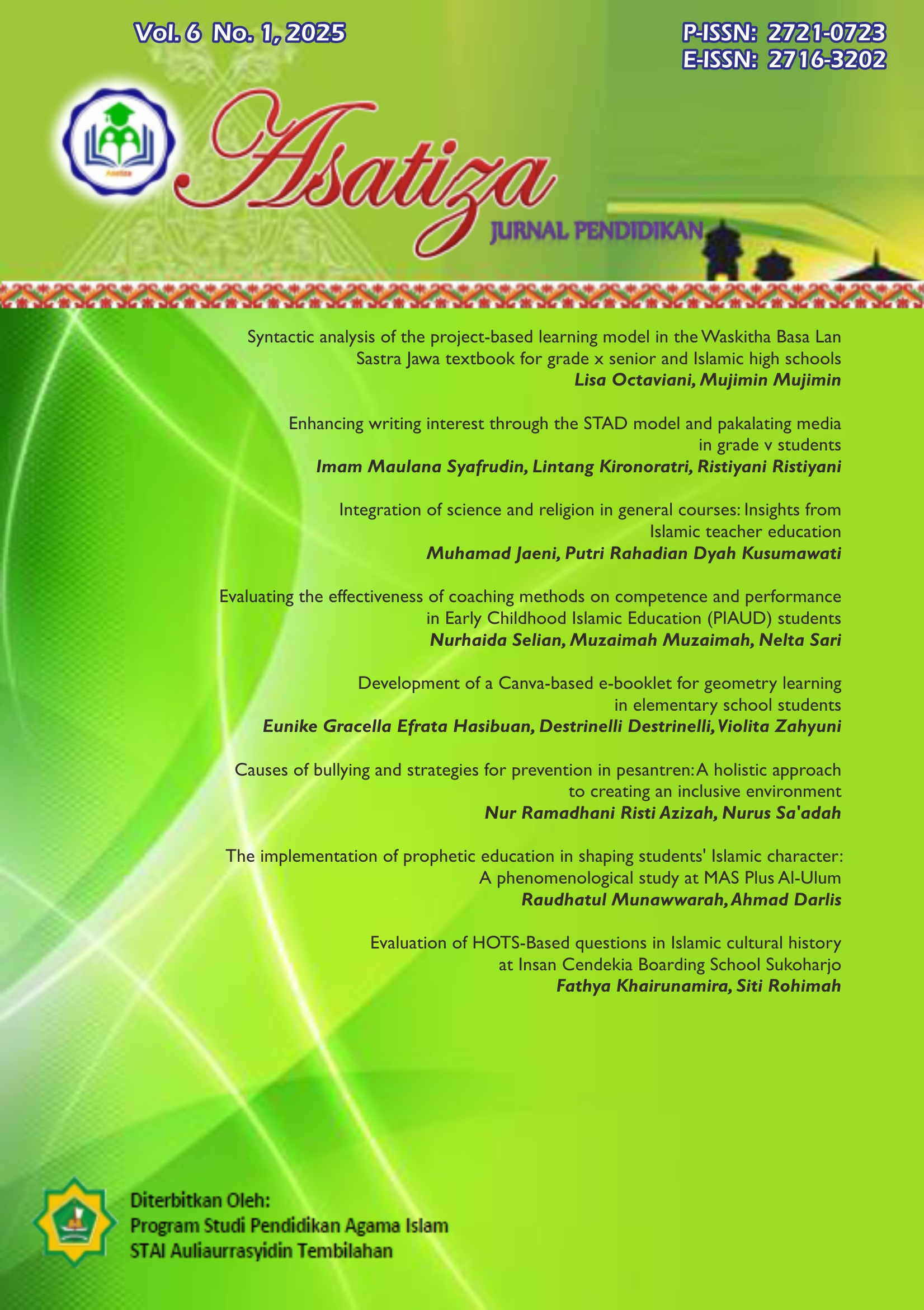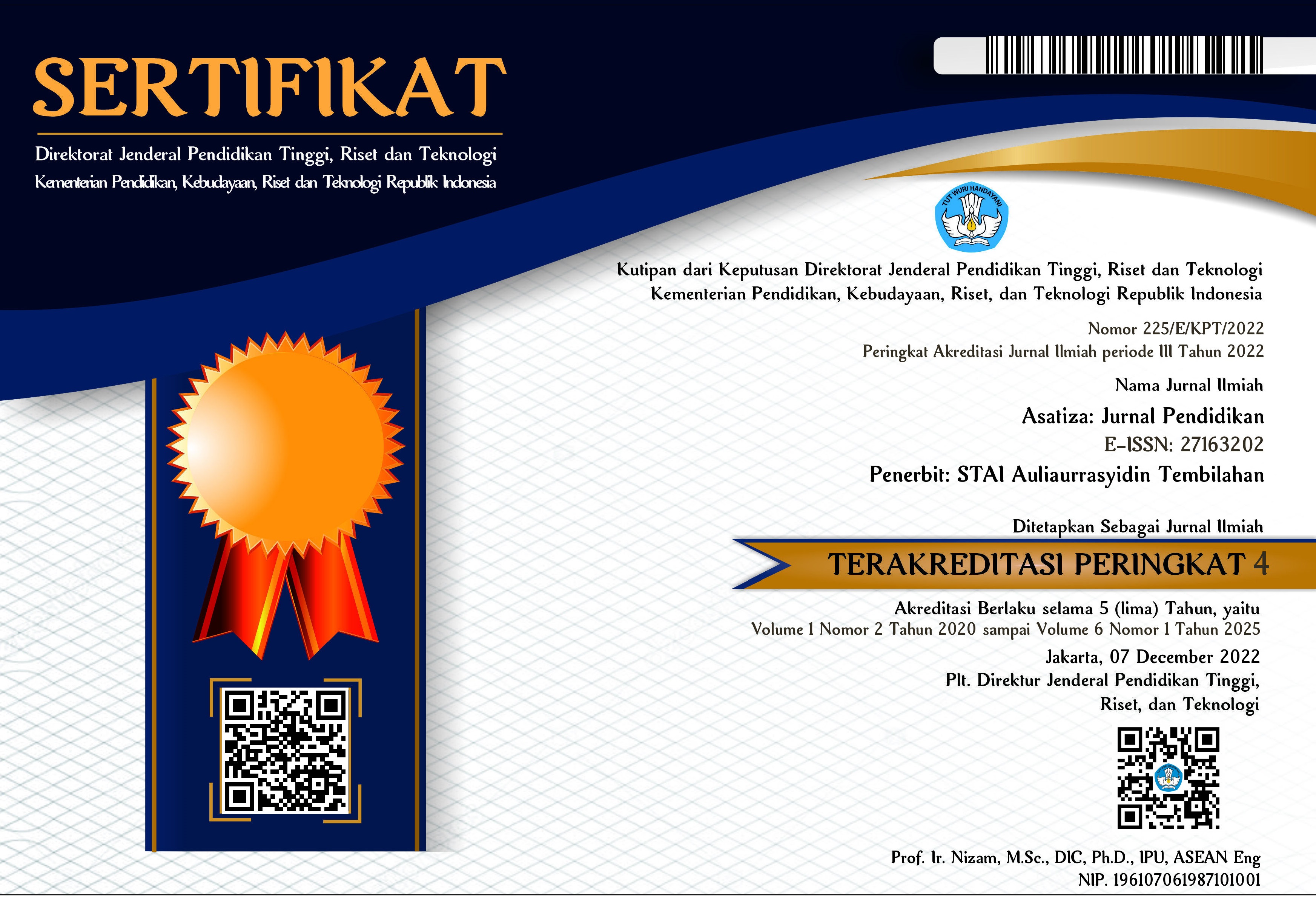Evaluation of HOTS-Based questions in Islamic cultural history at Insan Cendekia Boarding School Sukoharjo
DOI:
https://doi.org/10.46963/asatiza.v6i1.2621Keywords:
Higher Order Thinking Skills (HOTS), Educational Assessment, Islamic Cultural HistoryAbstract
This study evaluates the quality of Higher Order Thinking Skills (HOTS) questions in the Islamic Cultural History (SKI) subject for grade VIII students at SMP Insan Cendekia Boarding School Sukoharjo during the 2023–2024 academic year. Despite the Ministry of Religious Affairs’ initiative to promote HOTS-based assessments, their implementation in SKI examinations remains inconsistent. Using a qualitative descriptive approach, data were collected through interviews, observations, and document analysis. The interviews explored teachers' challenges in developing HOTS questions, including their understanding of HOTS, prior experience in question formulation, and implementation difficulties. Data were analyzed through data reduction, data display, and conclusion drawing. An analysis of 45 SKI exam questions revealed that none met HOTS criteria, with 39 classified under recall (C1) and 6 under comprehension (C2), while none reached application (C3) or higher. These findings indicate that the SKI exam does not align with HOTS development criteria, as it predominantly consists of lower-order thinking questions. Consequently, students rely on rote memorization rather than developing critical, analytical, and evaluative thinking skills. This study highlights the need to revise assessment frameworks and enhance teachers’ capacity in designing HOTS-based questions to foster deeper and more contextualized learning in Islamic history.
Downloads
References
Abduh, M. (2019). Panduan Penulisan Soal HOTS-Higher Order Thinking Skills. Jakarta: Pusat Penilaian Pendidikan.
Ahmad, D. N. (2020). Analisis Sistem Penilaian Hots (Higher Order Thinking Skills) Dalam Mengukur Kemampuan Berpikir Kritis Dan Kreatif. BIOTIK: Jurnal Ilmiah Biologi Teknologi Dan Kependidikan, 8(1), 11. https://doi.org/10.22373/biotik.v8i1.6600
Anderson, L.W., & Krathwohl, D. R. (2017). Kerangka Landasan Untuk Pembelajaran, Pengembangan, dan Asesmen. Yogyakarta: Pustaka Pelajar.
Arikunto, S. (2013). Dasar-dasar Evaluasi Pendidikan. Jakarta: Bumi Aksara.
Aripin, I. (2018). Pengembangan Soal-Soal Pilihan Ganda Untuk Mengukur Kemampuan Berpikir Kritis Siswapada Konsep Sistem Regulasi Manusia Untuk Jenjang Sma. Mangifera Edu, 3(1), 13. https://doi.org/10.31943/mangiferaedu.v3i1.242
Aryani. (2022). Pengertian Observasi dan Jenis-Jenis Observasi Penelitian. Jambi: UIN Jambi.
Asfiyah, S. (2021). Penilaian Berbasis High Order Thinking Skills dalam Meningkatkan Kemampuan Berpikir Kritis dan Kreatif pada Mata Pelajaran PAI dan Budi Pekerti. Quality, 9(1), 103. https://doi.org/10.21043/quality.v9i1.10136
Halimah, S. (2021). Implementasi Pendekatan Hots (Higher Order Thinking Skills) Dalam Pembelajaran Pai. Evaluasi: Jurnal Manajemen Pendidikan Islam, 5(2), 342–362. https://doi.org/10.32478/evaluasi.v5i2.762
Ilham Fahmi, M., Wahyu, D., Aisyah, S. A., Harto, K., & Suryana, E. (2023). Implementasi Asesmen Diagnostik Pada Mata Pelajaran Pendidikan Agama Islam Di Sekolah Menengah Kejuruan Negeri 1 Ogan Komering Ulu. FIKROTUNA: Jurnal Pendidikan Dan Manajemen Islam, 12(02), 184–197. https://doi.org/10.32806/jf.v12i02.7239
Komarudin. (2016). Penialian Hasil Belajar Pendidikan Jasmani dan Olahraga. Bandung: PT. Remaja Rosdakarya.
Magdalena, I., & Kumarani, N. C. (2023). Pengembangan Model Evaluasi Sumatif Mata Pelajaran PAI di Sekolah Dasar. Anwarul, 3(2), 300–311. https://doi.org/10.58578/anwarul.v3i2.981
Mahanal, S. (2019). Asesmen Keterampilan Berpikir Tingkat Tinggi. Jurnal Penelitian Dan Pengkajian Ilmu Pendidikan: E-Saintika, 3(2), 51. https://doi.org/10.36312/e-saintika.v3i2.128
Nurlitasari, A., & Hamami, T. (2023). Assessment as, for, of learning pembelajaran pendidikan agama Islam tingkat menengah atas. Humanika, 23(2), 225–234. https://doi.org/10.21831/hum.v23i2.61406
Ramadhani, F., Khuznul, S., & Taqwa, R. A. (2024). Implementasi Lots dan Hots Serta Implikasi Pada Proses Pembelajaran. 02(02), 154–164.
Primayana, K. H. (2019). Menciptakan Pembelajaran Berbasis Pemecahan Masalah Dengan Berorientasi Pembentukan Karakter Untuk Mencapai Tujuan Higher Order Thingking Skilss (HOTS) Pada Anak Sekolah Dasar. Purwadita: Jurnal Agama Dan Budaya, 3(2), 85–92. https://jurnal.stahnmpukuturan.ac.id/index.php/Purwadita/article/view/367
Rifa’i, N. H. dan M. R. (2023). Karakteristik Penilaian Pembelajaran Pada Kurikulum 2013 Di Mi. Awwaliyah: Jurnal PGMI, 4(1), 115–128.
Salsabila, Y. (2024). Analisis Penerapan Kurikulum Merdeka Pada Mata Pelajaran Sejarah Kebudayaan Islam (SKI) Kelas IV MI Salafiyah Tanjungsari. Al Ulya: Jurnal Pendidikan Islam 9(1), 65–84.
Setiawati, W., Asmira, O., Ariyana, Y., Bestary, R., & Pudjiastuti, A. (2019). Buku Penilaian Berorientasi Higher Order Thinking Skills. Direktorat Jenderal Guru Dan Tenaga Kependidikan Kementerian Pendidikan Dan Kebudayaan, 1–82.
Sugiyono. (2013). Metode Penelitian Pendidikan: Pendekatan Kuantitatif Kualitatif dan R&D. Bandung: Alfabeta.
Sugiyono. (2015). Metode Penelitian Pendidikan. Bandung: Alfabeta.
Downloads
Published
Issue
Section
License
Copyright (c) 2025 Fathya Khairunamira, Siti Rohimah

This work is licensed under a Creative Commons Attribution-ShareAlike 4.0 International License.
Authors who publish with this journal agree to the following terms:
1. Copyright on any article is retained by the author(s).
2. The author grants the journal, right of first publication with the work simultaneously licensed under a Creative Commons Attribution shareAlike 4.0 International License that allows others to share the work with an acknowledgment of the work’s authorship and initial publication in this journal.
3. Authors are able to enter into separate, additional contractual arrangements for the non-exclusive distribution of the journal’s published version of the work (e.g., post it to an institutional repository or publish it in a book), with an acknowledgment of its initial publication in this journal.
4. Authors are permitted and encouraged to post their work online (e.g., in institutional repositories or on their website) prior to and during the submission process, as it can lead to productive exchanges, as well as earlier and greater citation of published work.
5. The article and any associated published material is distributed under the Creative Commons Attribution-ShareAlike 4.0 International License











2.png)



